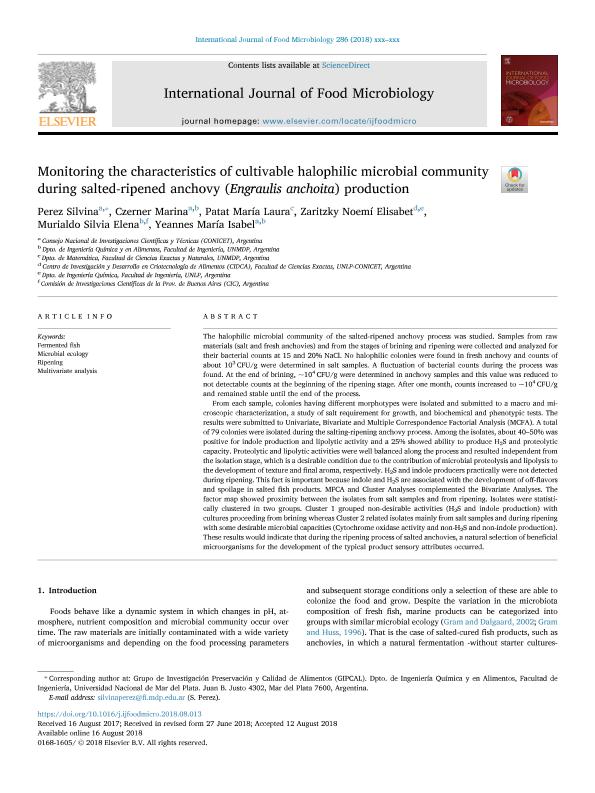Mostrar el registro sencillo del ítem
dc.contributor.author
Perez, Silvina
dc.contributor.author
Czerner, Marina

dc.contributor.author
Patat, María Laura

dc.contributor.author
Zaritzky, Noemi Elisabet

dc.contributor.author
Murialdo, Silvia Elena

dc.contributor.author
Yeannes, Maria Isabel

dc.date.available
2019-12-17T19:05:09Z
dc.date.issued
2018-08
dc.identifier.citation
Perez, Silvina; Czerner, Marina; Patat, María Laura; Zaritzky, Noemi Elisabet; Murialdo, Silvia Elena; et al.; Monitoring the characteristics of cultivable halophilic microbial community during salted-ripened anchovy (Engraulis anchoita) production; Elsevier Science; International Journal of Food Microbiology; 286; 8-2018; 179-189
dc.identifier.issn
0168-1605
dc.identifier.uri
http://hdl.handle.net/11336/92400
dc.description.abstract
The halophilic microbial community of the salted-ripened anchovy process was studied. Samples from raw materials (salt and fresh anchovies) and from the stages of brining and ripening were collected and analyzed for their bacterial counts at 15 and 20% NaCl. No halophilic colonies were found in fresh anchovy and counts of about 103 CFU/g were determined in salt samples. A fluctuation of bacterial counts during the process was found. At the end of brining, ~104 CFU/g were determined in anchovy samples and this value was reduced to not detectable counts at the beginning of the ripening stage. After one month, counts increased to ~104 CFU/g and remained stable until the end of the process. From each sample, colonies having different morphotypes were isolated and submitted to a macro and microscopic characterization, a study of salt requirement for growth, and biochemical and phenotypic tests. The results were submitted to Univariate, Bivariate and Multiple Correspondence Factorial Analysis (MCFA). A total of 79 colonies were isolated during the salting-ripening anchovy process. Among the isolates, about 40–50% was positive for indole production and lipolytic activity and a 25% showed ability to produce H2S and proteolytic capacity. Proteolytic and lipolytic activities were well balanced along the process and resulted independent from the isolation stage, which is a desirable condition due to the contribution of microbial proteolysis and lipolysis to the development of texture and final aroma, respectively. H2S and indole producers practically were not detected during ripening. This fact is important because indole and H2S are associated with the development of off-flavors and spoilage in salted fish products. MFCA and Cluster Analyses complemented the Bivariate Analyses. The factor map showed proximity between the isolates from salt samples and from ripening. Isolates were statistically clustered in two groups. Cluster 1 grouped non-desirable activities (H2S and indole production) with cultures proceeding from brining whereas Cluster 2 related isolates mainly from salt samples and during ripening with some desirable microbial capacities (Cytochrome oxidase activity and non-H2S and non-indole production). These results would indicate that during the ripening process of salted anchovies, a natural selection of beneficial microorganisms for the development of the typical product sensory attributes occurred.
dc.format
application/pdf
dc.language.iso
eng
dc.publisher
Elsevier Science

dc.rights
info:eu-repo/semantics/openAccess
dc.rights.uri
https://creativecommons.org/licenses/by-nc-sa/2.5/ar/
dc.subject
FERMENTED FISH
dc.subject
MICROBIAL ECOLOGY
dc.subject
RIPENING
dc.subject
MULTIVARIATE ANALYSIS
dc.subject.classification
Alimentos y Bebidas

dc.subject.classification
Otras Ingenierías y Tecnologías

dc.subject.classification
INGENIERÍAS Y TECNOLOGÍAS

dc.subject.classification
Bioprocesamiento Tecnológico, Biocatálisis, Fermentación

dc.subject.classification
Biotecnología Industrial

dc.subject.classification
INGENIERÍAS Y TECNOLOGÍAS

dc.title
Monitoring the characteristics of cultivable halophilic microbial community during salted-ripened anchovy (Engraulis anchoita) production
dc.type
info:eu-repo/semantics/article
dc.type
info:ar-repo/semantics/artículo
dc.type
info:eu-repo/semantics/publishedVersion
dc.date.updated
2019-10-15T14:10:33Z
dc.journal.volume
286
dc.journal.pagination
179-189
dc.journal.pais
Países Bajos

dc.journal.ciudad
Amsterdam
dc.description.fil
Fil: Perez, Silvina. Universidad Nacional de Mar del Plata. Facultad de Ingeniería; Argentina
dc.description.fil
Fil: Czerner, Marina. Universidad Nacional de Mar del Plata. Facultad de Ingeniería; Argentina. Consejo Nacional de Investigaciones Científicas y Técnicas. Centro Científico Tecnológico Conicet - Mar del Plata; Argentina
dc.description.fil
Fil: Patat, María Laura. Universidad Nacional de Mar del Plata; Argentina
dc.description.fil
Fil: Zaritzky, Noemi Elisabet. Universidad Nacional de La Plata. Facultad de Ingeniería; Argentina
dc.description.fil
Fil: Murialdo, Silvia Elena. Universidad Nacional de Mar del Plata. Facultad de Ingeniería; Argentina. Consejo Nacional de Investigaciones Científicas y Técnicas. Centro Científico Tecnológico Conicet - Mar del Plata; Argentina
dc.description.fil
Fil: Yeannes, Maria Isabel. Universidad Nacional de Mar del Plata. Facultad de Ingeniería; Argentina
dc.journal.title
International Journal of Food Microbiology

dc.relation.alternativeid
info:eu-repo/semantics/altIdentifier/url/https://linkinghub.elsevier.com/retrieve/pii/S0168160518305221
dc.relation.alternativeid
info:eu-repo/semantics/altIdentifier/doi/http://dx.doi.org/10.1016/j.ijfoodmicro.2018.08.013
Archivos asociados
